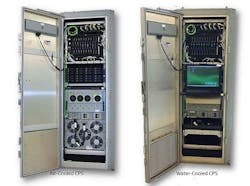Navy shipboard electronics experts choose open-architecture rugged computers from GTS
Officials of the Naval Sea Systems Command in Washington announced a $63.2 million order to GTS earlier this month for additional production of the Common Processing System (CPS) -- a shipboard computer processing system for on-board combat systems. The CPS is based on an open-architecture design. This order includes spare parts and engineering services.
The CPS provides a common computing infrastructure for ship combat systems, including processing and memory, data storage and extraction, and input-output interfaces for combat systems.
GTS engineers originally designed the CPS using commercial off-the-shelf (COTS) hardware and software such as BladeCenter technology that supplies common infrastructure for processing and network fabric. Plug-in components are accessible, hot-swappable, and battle-ready protected by the GTS Advanced COTS Enclosure (ACE).
The CPS consists of an enclosure and three subsystems: the processing subsystem, the storage/extraction subsystem, and the I/O subsystem. The processing subsystem provides the computing resources to execute navy combat system application programs on Navy surface ships.
The storage/extraction subsystem provides the mass storage resources required for operating system (OS) image storage, program storage, data extraction, and database management. And the I/O subsystem provides the resources required to interface the processing and storage hardware to various external elements.
The overall system is designed with a shock-isolating enclosure that protects unhardened COTS components from the intense shock and vibration that can occur on Navy surface ships -- including hits from missiles and torpedoes. The CPS comes in air- and water-cooled versions.
The CPS was designed originally to support upgrades to the Aegis weapon systems aboard Navy Ticonderoga-class cruisers and Arleigh Burke-class destroyers, but has been expanded to other Navy vessels.
GTS designed the system originally with a shock-isolating enclosure that protects unhardened COTS components from the intense shock and vibration that can occur on Navy surface ships -- including hits from missiles and torpedoes. The CPS comes in air- and water-cooled versions. The Leonardo DRS Computing and Networks Center of Excellence in Johnstown, Pa., also manufacturers the CPS.
On this order GTS will do the work in Virginia Beach, Va., and should be finished by May 2019. For more information contact GTS online at http://gts.us.com, or Naval Sea Systems Command at www.navsea.navy.mil.
Ready to make a purchase? Search the Military & Aerospace Electronics Buyer's Guide for companies, new products, press releases, and videos
